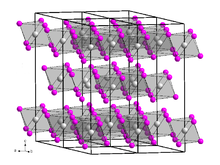Gadolinium(III) iodide is an iodide of gadolinium, with the chemical formula of GdI3. It is a yellow, highly hygroscopic solid with a bismuth(III) iodide-type crystal structure. In air, it quickly absorbs moisture and forms hydrates. The corresponding oxide iodide is also readily formed at elevated temperature.[2]
 | |
| Identifiers | |
|---|---|
3D model (JSmol) | |
| ChemSpider | |
| ECHA InfoCard | 100.033.619 |
| EC Number |
|
PubChem CID | |
CompTox Dashboard (EPA) | |
| |
| |
| Properties | |
| GdI3 | |
| Molar mass | 537.96 g/mol−1 |
| Appearance | yellow solid |
| Melting point | 926 °C[1] |
| Boiling point | 1340 °C[2] |
| Hazards | |
| GHS labelling: | |
  | |
| Danger[1] | |
| H317, H360 | |
| P201, P280, P308+P313[1] | |
| Related compounds | |
Other anions | Gadolinium(III) fluoride Gadolinium(III) chloride Gadolinium(III) bromide |
Other cations | Europium(III) iodide Terbium(III) iodide Samarium(III) iodide |
Related compounds | Gadolinium(II) iodide |
Except where otherwise noted, data are given for materials in their standard state (at 25 °C [77 °F], 100 kPa). | |
Preparation
Gadolinium(III) iodide can be obtained by reacting gadolinium with iodine:[2]
- 2 Gd + 3 I2 → 2 GdI3
It can also be obtained by reacting gadolinium with mercury(II) iodide in a vacuum at 500 °C:[2]
- 2 Gd + 3 HgI2 → 2 GdI3 + 3 Hg
Gadolinium(III) iodide can be obtained by the reaction between gadolinium(III) oxide and hydroiodic acid, crystallizing into the hydrate form. The hydrate form can be heated with ammonium iodide to form the anhydrous form.[2][3]
- Gd2O3 + 6 HI → 2 GdI3 + 3 H2O
Reactions
Gadolinium(III) iodide reacts with gadolinium and zinc in an argon atmosphere heated to 850 °C to obtain Gd7I12Zn.[4] It reacts with gadolinium, carbon, and gadolinium nitride in a tantalum tube at 897 °C to obtain nitrocarbide Gd4I6CN.[5]
References
External reading
- Asprey, L. B.; Keenan, T. K.; Kruse, F. H. Preparation and crystal data for lanthanide and actinide triiodides. Inorg. Chem., 1964. 3 (8): 1137-1240